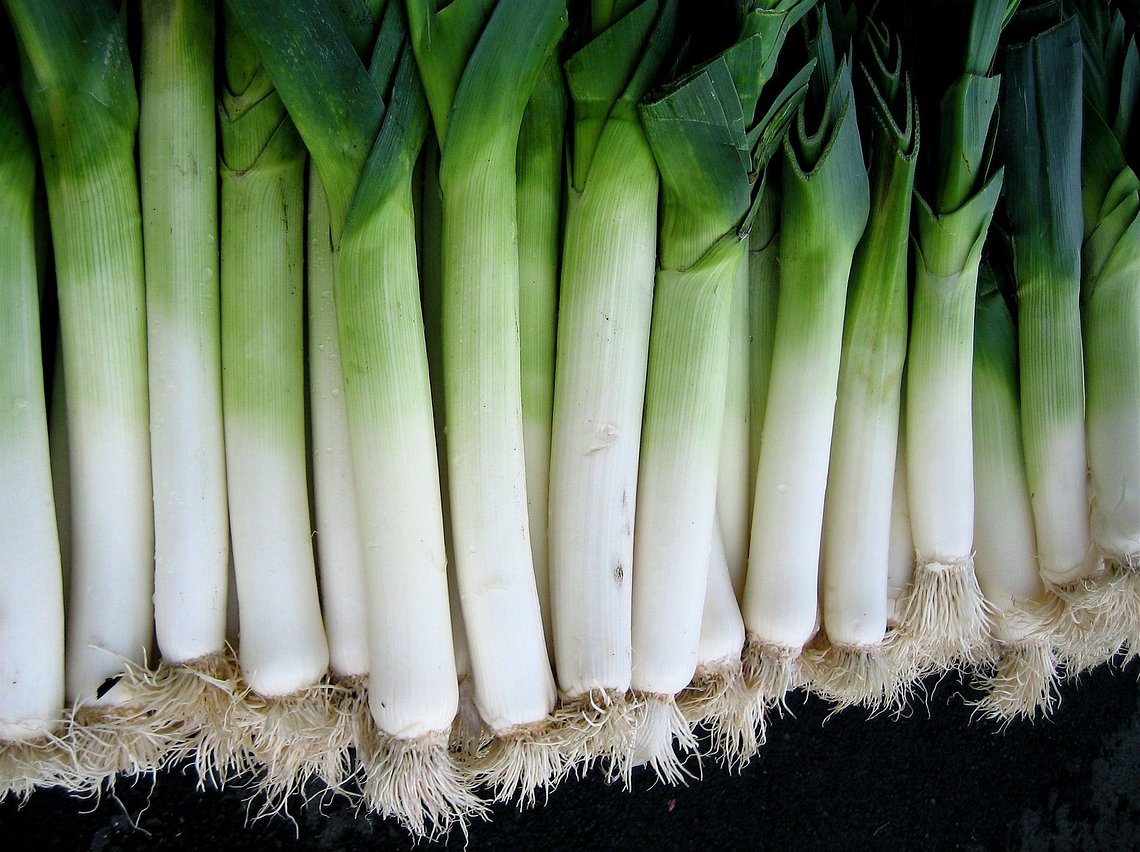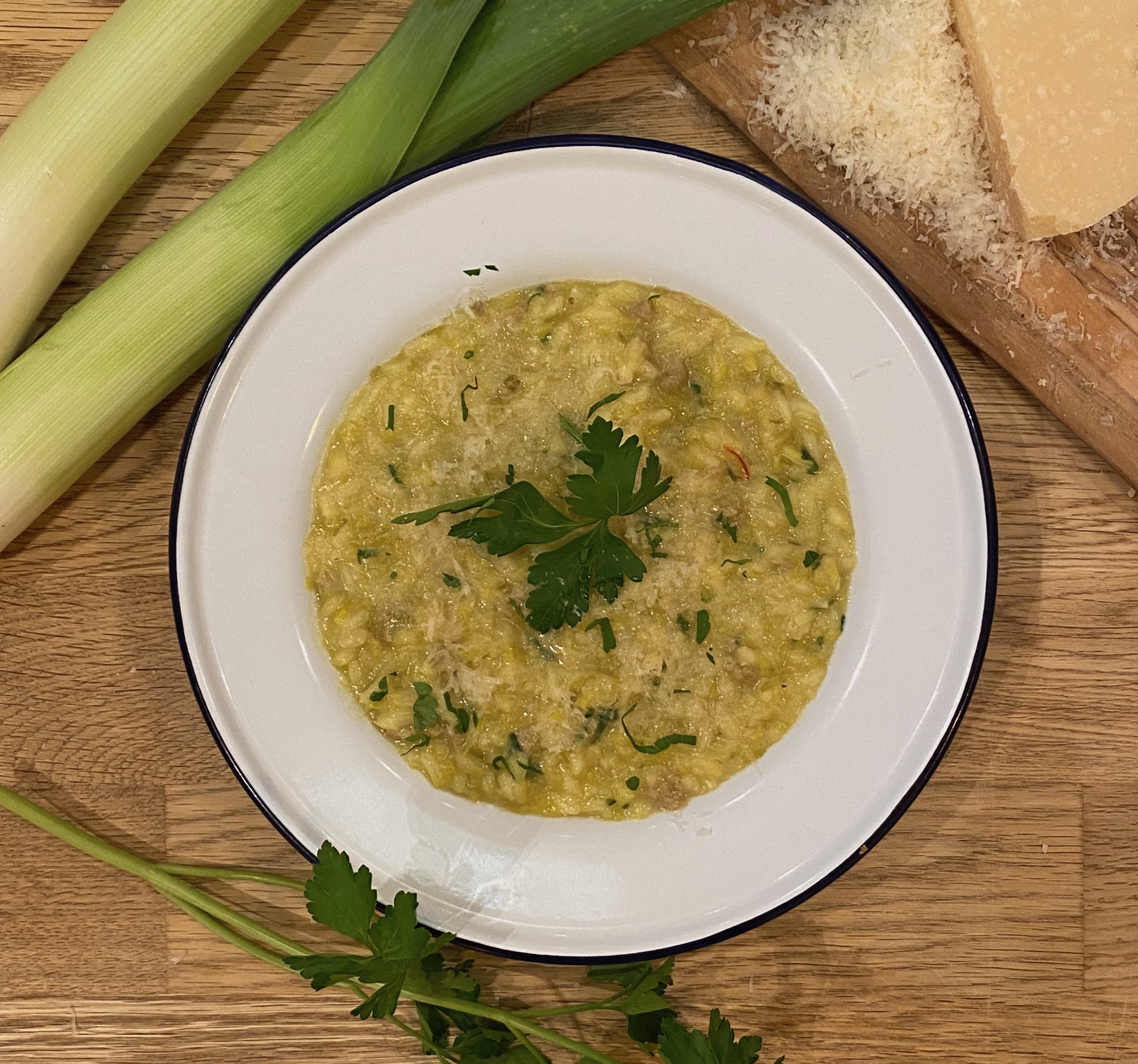January Eat the Seasons: Leeks
Mid winter can be a bit of a lean period for seasonal veg, but the noble leek is harvested throughout the colder months, and you can make all sorts of delicious things with it. All hail the leek! Check out our video recipe at the bottom of the page for our special leek, sausage and saffron risotto.

Posted on Sat 30 Jan 2021 · by Oliver Haenlein
Beautiful leeks are part of the allium family of onion-like plants, which includes things like garlic, chives and shallots. They are an ancient vegetable, native to the Middle-East originally. Leeks were celebrated in ancient Egypt and Greece, and in the Roman Empire where apparently they were eaten widely as they were thought to give you a stronger voice and help with singing and oration! The Romans later brought them to the UK, where they thrived due to the growing conditions. Of course they are now a proud symbol of Wales, which it just occurred to me, also has a great singing tradition!
Leeks grow straight up and out of the earth, and farmers pile soil around the vertical stalk as it gets taller, meaning it stays tender and white, unlike the tougher green part sticking out above.
We think it’s a rather underrated vegetable. There’s a unique and deep, grassy sweetness to a leek when it’s cooked down, and they also react to heat by breaking down into a wonderfully thick and almost creamy texture due to their ‘long-chain carbohydrates’. They are abundant in the UK in winter, and therefore cheap! Their flavour and consistency makes them perfect for winter warmer dishes.
What to look out for
Stay away from a leek that’s excessively large - with a stalk wider than around 3cm - these can be woody and weak in flavour. The green leaves at the top can be used for some things, but avoid a leek that has too much green down its length since we predominantly use the white part.
How to prep them
Trim off the root at the bottom, and the top two-thirds of the green part; this is usually too tough. If there are hard and discoloured leaves on the leek's stem, you can peel them off before you chop. There is often soil in between the layers of the leek; to wash this out you can slice it in half vertically and then rinse well under the tap.
Why are they good for you?
Friend of CED and guest nutritionist Emily Moreton (Insta: thenutrinurse) gives us the low down:
Leeks contain significant amounts of the flavonoid kaempferol. Research suggests kaempferol reduces the risk of us developing chronic diseases. They are also a great source of vitamin A, which supports our immune systems and aids our vision. Leeks are a prebiotic - a type of dietary fibre that feeds specific beneficial microbes. The benefits of prebiotics range from appetite regulation, supporting bone and skin health, to improving blood sugar control. Taking advantage of the naturally occurring prebiotics in leeks is the best way to feed your gut microbes. Pair leeks with some artisanal cheese thriving with bacteria and you’ve got yourself a tasty and surprisingly gut healthy duo!
What do they go with?
As Emily mentioned above, cheesy leeks in any form are a winner - a wonderful marriage of salty, sweet and oniony - think quiches, tarts, gratins, cooked in cheese sauce etc. To be honest they'll work with all manner of ingredients, they are very versatile, as are most alliums. Once cooked they have a great sweetness, so they beautifully offset anything salty (pancetta for example) or rich (they are beautiful cooked in butter or with cream)! The thick and silky texture they take on when sweated down makes them perfect for soups, stews and pie mixes. Chicken and leeks are great mates - e.g the Scottish cock-a-leekie soup!
Top tip?
Don't throw away those dark green leek tops - as in our recipe below use them with any other veg trimmings and a few carrots and celery sticks to make a delicious vegetable stock/broth.
Recipe Time!
We've paired leeks with sausage meat to make a delicious risotto. We've also added a little saffron to give the dish a delicate background warm note and touch of retro! If you prefer to eat something vegetarian, this will still be delicious without the sausage.

Leek, Sausage and Saffron Risotto
Watch the video recipe guide on Instagram HERE
Serves 4-6
- 1 carrot, 1 celery stick, parsley stalks and any other veg trimmings for the stock
- 3tbsp extra-virgin olive oil
- 3 small/medium leeks
- 2 large good quality pork sausages
- 300g risotto rice - we usually use Carnaroli
- 40g butter
- 50g grated Parmesan
- 1 large glass of dry white wine
- Large pinch of saffron strands
- Small handful of fresh parsley, finely chopped
- Salt and pepper
1 Cut the leeks in half vertically and run under a tap to rinse out any dirt caught in the leeks' layers. Cut off the top two-thirds of the green part as it's too tough to use in the risotto. Instead, simmer it in a few litres of water for at least half an hour with a chopped carrot, celery stick, parsley and any other veg trimmings you have lying around, to make the stock for the risotto.
2 Finely slice the rest of the leeks. Sweat in a deep pan over a medium/high heat with a pinch of salt. Cook for 5-10 mins until they have softened well.
3 Meanwhile, take a ladleful of your hot stock and pour it over the saffron strands in a small bowl. Allow the saffron to infuse into the stock, you'll see the liquid turn yellow!
4 Remove the skin from the sausages and add the meat to the leeks. Break it up with a wooden spoon. Continue to fry off the mixture on a medium heat for another 5-10 mins, until the leeks are sweated down really well, (they'll be super sweet now) and the sausage meat is cooked off and broken into very small pieces.
5 Pour in the risotto rice and mix well. 'Toast' off the rice in the mixture for a few minutes. Pour in the wine and mix well. Simmer for a few more mins until well thickened and the liquid has disappeared. Add the saffron and the liquid it's soaking in, mix well.
6 Add a few ladlefuls of the hot stock and stir over a medium heat until the liquid has reduced again. Add a few more ladles and repeat this process over and over until the rice is just cooked - it should still be a little 'al dente'.
7 Take the risotto off the heat, making sure there is still liquid in the mixture and it's not too dry (see video). The final risotto should be saucy, not stodgy. You can add a little more stock if it's not 'loose' enough. Allow to rest for a few mins.
8 Vigorously mix in the butter and cheese, with some chopped parsley, shaking the pan a little as you do so. This is called the 'mantecatura' - we are binding the melting fats to the starch from the rice and massively boosting the creaminess of the risotto. Taste, and season well with salt and pepper. Serve and enjoy :)
